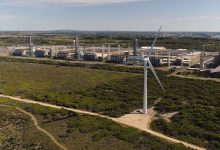Volvo and Holcim to Use Autonomous Electric Haulers in a Limestone Quarry
Volvo Autonomous Solutions and Holcim Switzerland have partnered to jointly test and further develop the use of autonomous electric haulers in a limestone quarry. The two companies are dedicated to seeking infrastructure and transport solutions that are safe, efficient, innovative, and sustainable.
Holcim’s quarry Gabenchopf in Siggenthal has been chosen as the site for this project. The battery-electric haulers currently being tested mark a ground-breaking step in the industry: not only are they quieter and more sustainable than conventional haulers, but they are also safer – in fact, they are the world’s first commercially available CE-certified electric, autonomous transport solution for the quarry and cement industries.
“This project show-cases a sustainable transport solution that is commercially viable and combines the technology shifts of connectivity, automation and electrification,” says Nils Jaeger, President of Volvo Autonomous Solutions. “Through a strong partnership with Holcim Switzerland this will happen in a real environment driven by two committed companies dedicated to jointly presenting the future.”
“We are delighted to partner with Volvo on this project,” says Simon Kronenberg, CEO of Holcim Switzerland, and Italy. “Our participation in this project represents another step towards fulfilling our sustainability objectives: we seek solutions that are both innovative and environmentally responsible and we are constantly investing in measures to reduce our ecological footprint in order to help build a sustainable future.”
For Holcim, logistics plays a major role in the world-wide efforts to reduce the impact on climate: “Here, we as a company can contribute already today while we continue to work on the development of CO2-reduced technologies and products.” Related, and equally important, is the issue of renewable energy: Holcim has been using 100% renewable electrical energy at all sites since 2019 and makes a point of using only green energy for electrically powered vehicles such as the electric concrete truck mixers that are already in use.
The testing and likely deployment of electric haulers in its quarry is part of Holcim’s digitization initiative ‘Plants of Tomorrow’. As part of the initiative, Holcim is testing automation technologies, robotics, and artificial intelligence throughout the entire production process to develop innovative solutions for a safer, more efficient, and more sustainable cement production.
“Volvo’s ambition is nothing less but to bring the future of infrastructure and transport solutions to our customers in a commercially viable way, and this innovative commercial project represents the next phase of this journey,” concludes Nils Jaeger.
The move to autonomous machines will not be simply a case of replacing a machine with an operator to one without. Autonomous machines will prompt the automation of the whole process and require a new way of looking at the entire operation. Volvo Autonomous Solutions was created on January 1st 2020 to develop and commercialize autonomous transport solutions for the whole Volvo Group.
As well as providing adapted machines from within the Volvo Group, Volvo Autonomous Solutions will support customers with solutions to autonomous machines’ other challenges, namely the supporting infrastructure, control towers, repair and maintenance, virtual drivers and even run the operations if needed. “It’s as much about a new mindset as it is about developing autonomous machines,” says Uwe Müller, sales, and marketing lead for Off Road Solutions at Volvo Autonomous Solutions. “We are talking about automating a transport process, not just selling a single machine. Because of that we need to develop a total solution to manage this full process.”
Autonomous enabled platforms
Volvo Autonomous Solutions is working closely with the Volvo Group’s other business areas, especially Volvo Construction Equipment in the off-road segment. This ensures that new machines, whether developed specifically to be autonomous – like Volvo’s award-winning TA-15 hauler – or traditional operator-based equipment, use the same autonomous drive platforms, coding languages etc. This allows them to be ‘talked to’ in the same way, as well as offering the ability to scale up easily. Not all machines will be autonomous but being ‘autonomous enabled’ allows Volvo Autonomous Solutions to supercharge the standard products into operator-less machines, using its own proprietary autonomous drive kit.
Quarries and mines
“To reduce the complexity of the world we need to standardize the process as much as possible,” says Müller. “In quarries we can do this as they are in a confined area, are highly regulated and it’s easier to separate autonomous transport from other processes. Involving loading and dumping, the process itself is simple and repetitive.”
Improved process optimization, lower energy consumption and improved safety are just three of the benefits of autonomous machines. There are lots of R&D challenges to be overcome – and they will be. But it won’t be a technical innovation that makes the breakthrough – that requires changes in legislation and a new mindset as to how the whole process can operate more effectively. Make no mistake, autonomous solutions are coming, and they will be disruptive to current business models.
TA15 autonomous hauler concept: rethinking how quarries operate
The TA15 is the result of continuous development of previous concept models. The machine is now part of the TARA autonomous transport solution, which consists of several components — the base vehicles (multiple TA15s), plus required infrastructure such as charging stations, a control tower, connected cloud solutions designed to meet customer operation requirements, maintenance and repair support, and the practical operations set-up which varies site to site.
The intended use of the TA15 is to transport material in repetitive flows in confined off-road environments like quarries. The number of machines and respective charging stations will depend heavily on the target production/transport volumes as well as the haul cycle. It can start as a small fleet of 3-4 machines and go up to bigger fleets of 15-20 machines running in a coordinated effort on a site. The fleet of TA15 machines will interact closely with the respective loading equipment at the site (e.g., wheel loaders or excavators) and be supervised and controlled from a central, onsite control room.
The TA15 machines are designed for high-power opportunity charging which is a natural part of the haul cycle. This means the machines can in principle be charged every cycle with the amount of energy they need to run the next cycle. The charging process is fully autonomous, using a 150-kw high-power charger that connects via a pantograph on the ground to a pick-up on the bottom side of the TA15. The charge time will vary from approximately one minute up to three minutes depending on the amount of energy needed.
Benefits of an autonomous transport solution
- Increased energy efficiency due to the electric drivetrain and innovative design of the base machine
- Lower emissions (zero local emissions) due to the battery-powered driveline
- Increased safety
- An overall increase in process productivity due to the combination of automation, electrification, and connectivity







